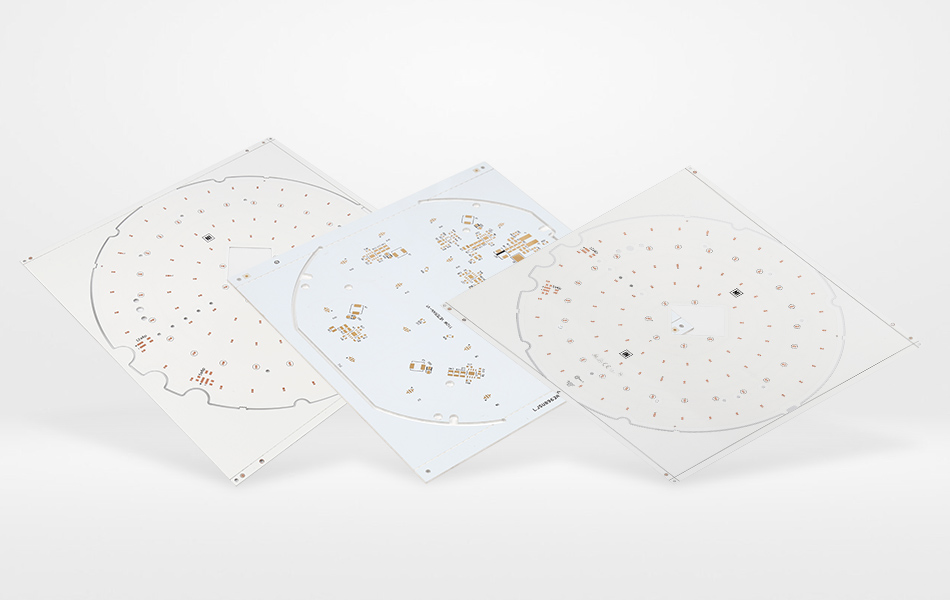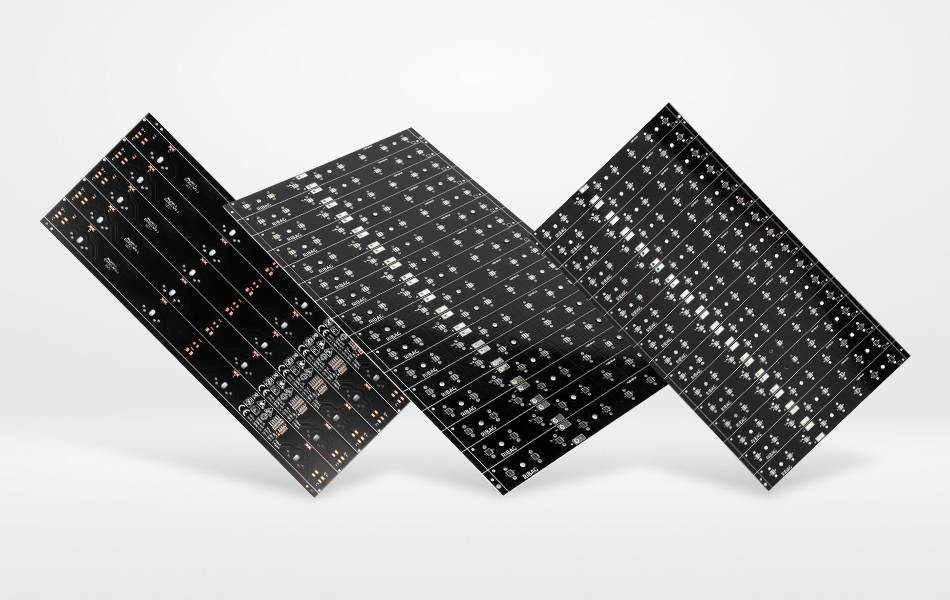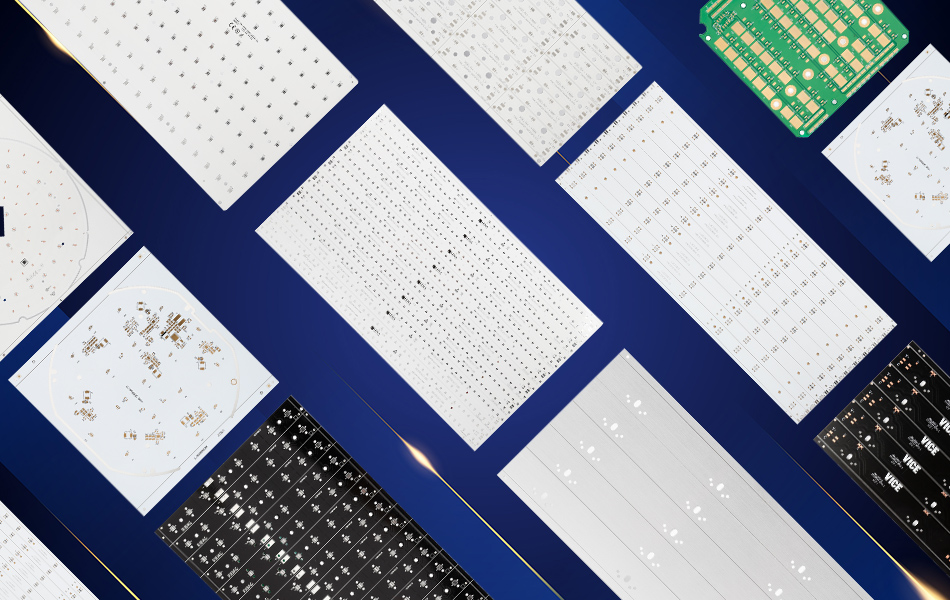-
- PCB TYPE
- PRINTED CIRCUIT BOARD PROTOTYPE ALUMINUM PRINTED CIRCUIT BOARD R&F PCB FPC HIGH FREQUENCY PCB HIGH-TG PCB HEAVY COPPER PCB HDI PCB PCB FOR LIGHTING METAL CORE PCB
time:Jul 23. 2025, 12:11:26
In the fast-evolving landscape of modern electronics, aluminum PCBs (Printed Circuit Boards) have emerged as a pivotal technology, bridging the gap between thermal efficiency, mechanical durability, and design versatility. As electronic systems grow increasingly power-dense—from automotive electrification to high-performance consumer devices—traditional FR-4 PCBs often struggle to manage heat buildup, leading to performance degradation and shortened lifespans. Aluminum PCBs address this critical challenge through innovative material engineering, leveraging the thermal conductivity of aluminum to dissipate heat while maintaining reliable electrical performance. This article explores the fundamental principles, core advantages, diverse applications, and future trends of aluminum PCBs, ensuring industry industry expertise and alignment with search engine optimization (SEO) best practices.
Material Composition and Structural Design of Aluminum PCBs
Aluminum PCBs are engineered as multi-layer composites, with each component optimized to balance thermal, electrical, and mechanical functionality:
Core Layer Architecture
Aluminum Substrate: The foundational layer, selected for its exceptional thermal conductivity and lightweight properties. Unlike rigid ceramic substrates or heavy copper cores, aluminum offers a cost-effective solution that efficiently spreads heat while providing structural stability. This makes it adaptable to applications ranging from compact LED modules to large-scale industrial inverters.
Thermally Conductive Dielectric Layer: A thin insulating layer positioned between the aluminum substrate and copper circuit layer. Composed of materials such as ceramic-reinforced epoxies, polyimides, or specialized polymers, this layer ensures electrical isolation between the aluminum and copper while facilitating heat transfer from the circuit layer to the substrate. Formulations vary by use case: high-temperature variants withstand underhood automotive environments, while general-purpose options suit consumer electronics.
Copper Circuit Layer: High-purity copper foil bonded to the dielectric layer via advanced lamination processes. This layer forms conductive pathways for electrical signals, with uniform thickness to minimize resistance and enhance heat spreading from active components like LEDs, transistors, and microchips.
This layered structure creates a synergistic thermal-electrical system, where heat flows unimpeded from components through the copper layer, across the dielectric, and into the aluminum substrate—eliminating the thermal bottlenecks common in traditional PCBs.

Core Advantages of Aluminum PCBs
Aluminum PCBs offer distinct benefits that set them apart from conventional PCB materials, making them indispensable in modern electronics:
Superior Thermal Management
Efficient Heat Dissipation: The aluminum substrate acts as a natural heat sink, rapidly distributing heat away from high-power components. This reduces thermal hotspots—a primary cause of component failure in power-dense systems such as LED drivers, motor controls, and battery management units.
Thermal Uniformity: By minimizing temperature gradients across the PCB surface, aluminum PCBs ensure consistent performance of heat-sensitive components like sensors and semiconductors, which rely on stable operating temperatures to maintain accuracy.
Enhanced Mechanical and Environmental Durability
Vibration and Impact Resistance: The aluminum substrate’s rigidity and toughness make these PCBs highly resistant to mechanical stress, ideal for applications in automotive, aerospace, and industrial machinery where vibration and shock are common.
Corrosion and Moisture Resistance: Surface treatments such as anodization, conformal coatings, or solder masks protect the aluminum substrate from moisture, chemicals, and UV exposure, extending service life in outdoor environments like streetlights, solar inverters, and marine electronics.
Design Flexibility and Cost Efficiency
Versatile Configurations: Aluminum PCBs support diverse designs, including single-layer, multi-layer, and flexible variants. This adaptability enables customization for compact devices (e.g., wearables) and large-scale systems (e.g., industrial control panels).
Balanced Performance and Affordability: Compared to ceramic PCBs, aluminum PCBs offer a more cost-effective solution without sacrificing thermal or mechanical performance, making them accessible for high-volume consumer electronics and demanding industrial applications alike.

Industry Applications of Aluminum PCBs
Aluminum PCBs are transforming electronics across sectors, enabling innovation where thermal management and reliability are critical:
Automotive Electronics
LED Lighting Systems: Used in headlights, taillights, and interior lighting, aluminum PCBs dissipate heat from high-output LEDs, ensuring consistent brightness and preventing premature degradation. Their vibration resistance further enhances durability in vehicle environments.
Power Electronics: In electric and hybrid vehicles, aluminum PCBs manage heat in battery management systems (BMS), inverters, and motor controllers. Efficient thermal dissipation is critical here to maintain battery safety and extend operational range.
ADAS and Sensing Modules: Support advanced driver-assistance systems (ADAS) such as cameras, radar, and LiDAR sensors, where thermal stability ensures reliable operation in fluctuating underhood temperatures.
Consumer Electronics and Lighting
LED Lighting Solutions: Power residential, commercial, and outdoor LED fixtures—from bulbs and panels to streetlights. Aluminum PCBs enhance energy efficiency by dissipating heat, extending LED lifespans, and reducing maintenance costs.
Smart Devices and Appliances: Used in smartphones, tablets, gaming consoles, and home appliances, where compact design and thermal management prevent overheating during extended use, improving user experience and device longevity.
Industrial and Energy Systems
Industrial Automation: Power motor drives, programmable logic controllers (PLCs), and sensor networks in factories. Aluminum PCBs withstand dust, vibration, and temperature extremes, ensuring uninterrupted production in harsh industrial environments.
Renewable Energy Equipment: Integrated into solar inverters, wind turbine controls, and energy storage systems. Their ability to dissipate heat in outdoor installations optimizes energy conversion efficiency and reliability.
Telecommunications and IoT
Networking Infrastructure: Support routers, switches, and base station components in data centers and communication towers. Thermal management ensures stable performance in high-density environments where equipment operates continuously.
IoT and Wireless Sensors: Power smart home devices, industrial IoT (IIoT) sensors, and environmental monitors. Aluminum PCBs’ compact design and durability make them suitable for embedded and remote applications.

Manufacturing and Quality Assurance for Aluminum PCBs
The production of aluminum PCBs involves specialized processes to ensure consistent performance and reliability:
Advanced Manufacturing Techniques
Precision Lamination: The aluminum substrate, dielectric layer, and copper foil are bonded under controlled temperature and pressure to ensure uniform adhesion, minimizing thermal resistance at layer interfaces and maximizing heat transfer efficiency.
High-Accuracy Etching: Laser or chemical etching creates precise circuit traces and vias, enabling high-density designs for compact electronics while maintaining electrical conductivity and thermal performance.
Surface Treatment: Protective coatings—such as solder masks, conformal coatings, or anodization—are applied to enhance corrosion resistance, solderability, and environmental protection, tailoring the PCB to specific application needs.
Quality Control Protocols
Thermal Performance Testing: Infrared (IR) imaging and thermal resistance analysis validate heat dissipation capabilities, ensuring PCBs meet application-specific thermal requirements.
Mechanical and Environmental Testing: Samples undergo vibration, shock, thermal cycling, and humidity testing to simulate real-world conditions, verifying durability in harsh environments.
Electrical Validation: Insulation resistance, continuity checks, and high-potential (hipot) tests ensure electrical performance meets industry standards, with no short circuits or signal loss.

Emerging Trends in Aluminum PCB Technology
Aluminum PCB innovation is driven by evolving industry demands for higher performance, sustainability, and integration:
Material Advancements
Nano-Enhanced Dielectrics: Research into nanomaterials (e.g., boron nitride, aluminum oxide) in dielectric layers aims to boost thermal conductivity while maintaining electrical insulation, enabling higher power densities in compact designs.
High-Temperature Formulations: Development of dielectric materials with improved heat resistance supports applications in extreme environments, such as aerospace electronics and high-power industrial systems.
Sustainability and Circular Design
Recyclable Materials: Increased use of recycled aluminum substrates and eco-friendly dielectric components reduces environmental impact, aligning with global sustainability initiatives.
Energy-Efficient Production: Adoption of renewable energy sources and lean manufacturing processes minimizes resource consumption during PCB production, lowering carbon footprints.
Integration with Emerging Technologies
Flexible Aluminum PCBs: Thin, flexible designs enable integration into curved surfaces and wearable devices, combining thermal efficiency with mechanical adaptability.
Smart Thermal Management: Integration of sensors and thermal interface materials (TIMs) enables real-time temperature monitoring and adaptive cooling, optimizing performance in dynamic applications like electric vehicle batteries and 5G base stations.

Conclusion
Aluminum PCBs have become a cornerstone of modern electronics, offering a unique blend of thermal management, mechanical durability, and design flexibility. From automotive electrification and LED lighting to industrial automation and renewable energy, these PCBs address the critical challenge of heat dissipation in power-dense systems, enabling innovation and reliability. As industries continue to demand higher performance, compact designs, and sustainable solutions, aluminum PCBs will remain at the forefront—providing engineers and manufacturers with a versatile platform to build the next generation of electronic systems.
Keywords: aluminum PCB, thermal management, automotive electronics, LED lighting, industrial automation, sustainable manufacturing, PCB technology.
This article provides a comprehensive, technically rigorous overview of aluminum PCBs, emphasizing their material science, applications, and future trends while ensuring originality, SEO optimization, and alignment with industry best practices.

Got project ready to assembly? Contact us: info@apollopcb.com



We're not around but we still want to hear from you! Leave us a note:

Leave Message to APOLLOPCB
